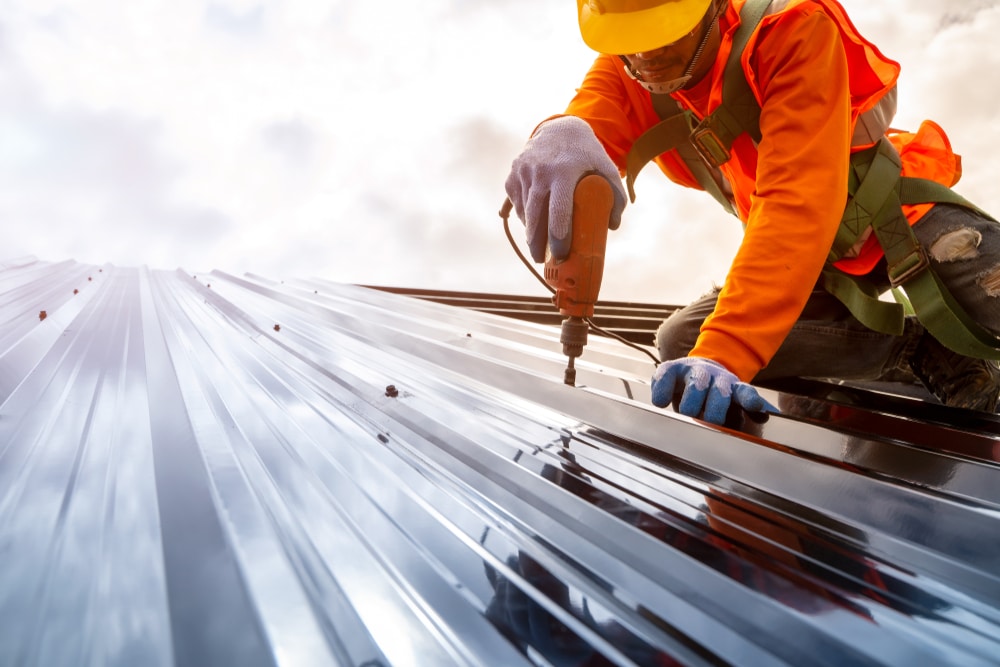

Commercial roofing is any type of roofing fitted to a commercial building. It’s easy to assume that commercial roofing is the same as residential roofing—they’re both just buildings, right? But in reality, commercial buildings are usually much larger, and have a number of different considerations and requirements for their roof.
In this article, we’ll explore the difference between commercial roofing and residential roofing, and factors to consider when choosing a commercial roofing material.
Installing roofing for a residence tends to be much simpler than installing roofing for a commercial building. Commercial roofs tend to be larger, with the project requiring more material, planning, and time.
They also have additional considerations that are missing from residential installs. A commercial building may have an extensive ducted air conditioning system, which must be taken into account for the install. There may be external piping that needs to penetrate the roof, which must be cut and sealed correctly to prevent leaks. The building might have a large number of lights spanning the ceiling, producing considerable heat that the roof needs to withstand.
Residential and commercial roofing also differ in gradient, with houses usually having steeper roofs than offices, shops, and other commercial buildings. This is because roofs are more visible for houses due to being shorter, with many homeowners preferring the slanted look. It’s also because a steep roof makes it easier for rain to flow away, without pooling on its surface and causing long-term damage.
Finally, the materials used for commercial roofing are different to residential. Commercial roofs tend to use metal, concrete, and sometimes asphalt,1 whereas residences primarily use concrete or clay tiles, or sheet materials like corrugated iron.2 There are more materials available for commercial roofing, which makes the decision trickier, and requires the help of a professional.
Every commercial building is different, and every building owner will have their own budget. When deciding on a roof material for your commercial building, you’ll need to consider cost, time constraints, strength, durability, temperature resistance, and aesthetic concerns. Let’s explore each of these.
Cost is usually the biggest concern for the building owner. Most people want the roof to be installed as cheaply as possible, in which case metal sheets or asphalt might be the best bet, although this depends on other factors for the job.
Building projects are often delayed, which can result in the roof needing to be installed as quickly as possible to catch up. If this is the case, again, asphalt or metal sheets are good materials because they can be installed quickly.
A roof can be separated into two parts—the cladding, and the internal support structure that holds up the roof. The amount of weight that the roof can carry without collapsing is its load bearing capacity, which differs depending on the requirements of the building. For example some commercial building owners might want to install rows of solar panels, large satellite dishes, solar hot water systems, or other heavy equipment, in which case the load bearing capacity needs to be higher. If this is the case, a stronger material such as steel or concrete might be the best options.
Durability is an important factor to consider when choosing a new roof, particularly if you live in an area where thunderstorms are common. Zincalume or Colorbond roofs are cost effective, have great strength, and correctly installed can last over 40 years. At the other end of the scale, plastic polymer is one of the most expensive materials to use for a roof, but will usually last upwards of 50 years before needing to be replaced.3
If a commercial or industrial building is subject to extremely high or low temperatures, and this happens on a regular basis, the roof’s material is an important consideration. Metal cladding with insulation is one of the best materials for withstanding high temperatures, and would be a good choice for a commercial building that regularly experiences them.
Commercial buildings tend to be taller than residential buildings, which makes their roof more difficult to see, and the look less important. But some commercial building owners might be proud of their building’s appearance, and want a good-looking roof that complements everything else. If this is the case, they might want to consider a material such as slate, terracotta, satin or matt finish Colorbond steel which look beautiful, and last for long periods of time.
References
At some point in your home-owning journey, you'll likely need to hop on a ladder…
A gutter system is crucial to protecting your home and roof. It minimises leaks and…
You’ve noticed some warning signs you need a new roof for your home. As an…
Knowing how to clean gutters isn’t the sexiest skill to have, but it’s essential for…
Along with the frame, the roof is amongst a home’s most critical structural elements. It…
Whether you’re building a new home, or renovating an old one, metal is one of…